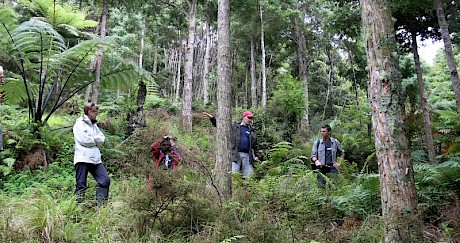Mangeao (Litsea calicaris)
History
Early settlers rapidly discovered that Mangeao was a very high quality timber with strength and bending capabilities that were very similar to ash. Accordingly it was used for such purposes as timber jack frames, ships blocks, boat frames, medium strength handles, railway carriages and sporting goods. Later it was used to produce high quality sliced veneer. Maori people used it for its medicinal properties in vapour baths and midwifery.
Distribution
The genus is of tropical origin, also being found in Indonesia, Malaysia and New Caledonia. In New Zealand mangeao is found from North Cape south to near Mokau, Rotorua and East Cape. Strangely for a tree of tropical origin, it is commonest in the southern part of its range, especially in the hilly country between Te Kuiti and the west coast and the Kaimai Ranges between Katikati and Rotorua. Little information is available on its site preferences and climatic limits. However it is noted as being frost tender when young and prefers soils derived from limestone, weathered pumice and heavy clays. It does not thrive on poorly drained soils or in areas subject to drought.
Tree size
The “Flora of New Zealand Vol 1” records mangeao as growing to 12 metres tall and 80 cm diameter although other sources record greater dimensions. The only one listed by Burstall and Sale was planted at Putiki Mission House by the Rev Richard Taylor in 1860. At about 120 years old it was 13 metres tall with a trunk diameter of 92 cm.
Timber
The timber of mangeao is described as being white, firm, strong and of great elasticity, being suitable for a great variety of purposes requiring strength, toughness and elasticity with light weight. Timber characteristics, with P radiata figures shown in brackets for comparison, are as follows:
Density: 595 kg/ m³ (500 kg/m³)
Moisture content: green 100% (130%)
Tangential shrinkage - green to 12% m.c 5.9% (4.7%)
Radial shrinkage 2.3% (2.2%)
Modulus of rupture 78 Mpa (90 Mpa)
Modulus of elasticity 8.8 Gpa (9 Gpa)
It should be noted that the above figures do not do justice to the most valuable property of mangeao – its general toughness and elasticity. It is rated as being four times tougher than P radiata.
Potential
Mangeao’s potential for management is relatively unknown, as this is a species which never appears to have been considered for forestry purposes in the past. Some information on its potential growth rate was reported by Pardy et al, 1992. They found that height mean annual increments (MAI) ranged between 0.25 and 0.66 metres while diameter MAI’s ranged from 0.4 cm to 1.86 cm. Indications from these limited measurements indicate that mangeao, given optimum conditions, could grow reasonably fast and reach 16 metres tall and 45 cm diameter in 25 years. Potential uses are many and varied. Apart from those listed above, other current uses are in the crafting of violins (by G H Thatcher in Hamilton) and it is the native wood of choice for the ribs of high quality kayaks.
Research requirements
It would be desirable to consider planting trials of mangeao on optimum sites. This could be done in either the Rotorua or Te Kuiti areas.
References
- Allan H H 1961 Flora of New Zealand Vol. 1 Government Printer Wellington
- Brooker S G, Cambie R C & Cooper R C 1981 New Zealand Medicinal Plants. Heinmann
- Burstal S W & Sale E V 1984. Great Trees of New Zealand
- Clifton N C 1990. New Zealand timbers
- Hinds H V & Reid J S 1957 Forest Trees and Timbers of New Zealand. Govt Printer Wellington
- Howard A L 1948 The timbers of the world. MacMillan & Co, London
- Mortimer J & B 1984 Trees for the New Zealand Countryside. Silverfish
- Pardy G F, Bergin D O & Kimberley M O 1992. Survey of Native tree plantations. FRI Bulletin 175
Species profile by Ian Barton


